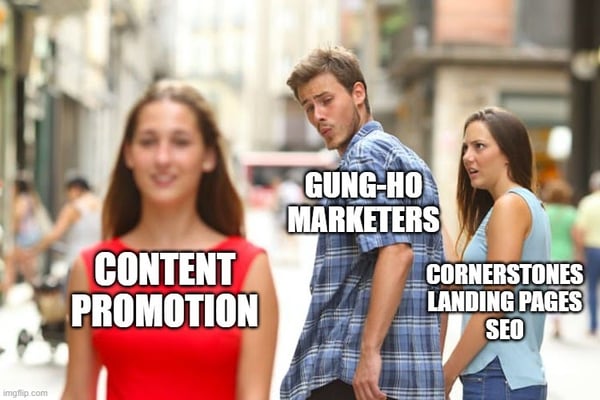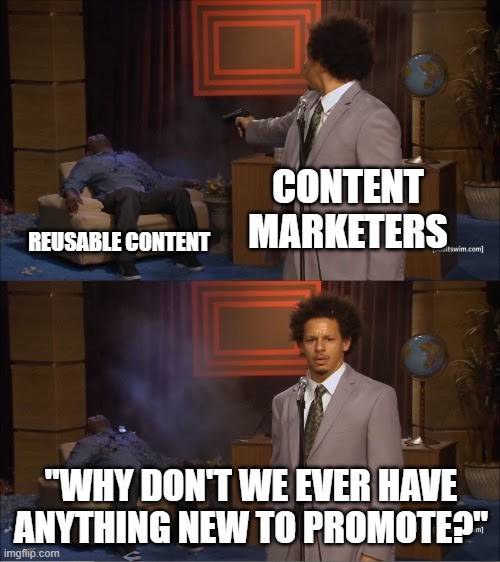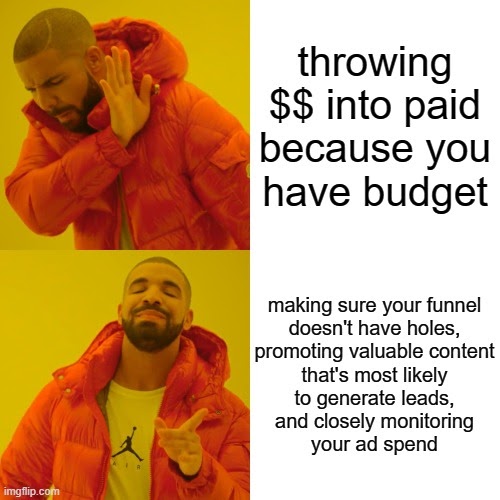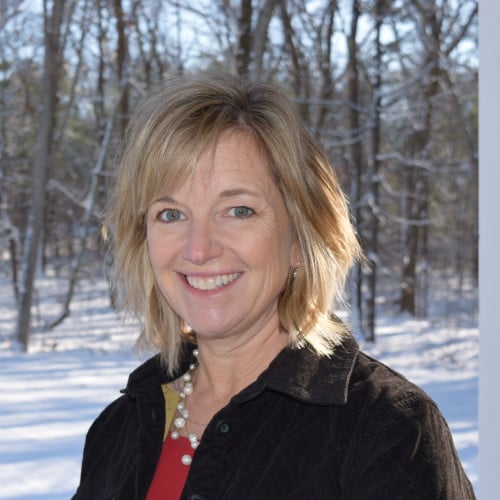May 13, 2020
 by Amanda Cyr / May 13, 2020
by Amanda Cyr / May 13, 2020

Hey all you cool cats and kittens!
Let’s face it. Most of us will never be Carole Baskin (whew) but that doesn’t mean we shouldn’t be as savage when it comes to feeding our content to the world. You know, if our content is a first husband and the world is a hungry tiger.
Open missing person cases aside, here’s what the content marketing lifecycle looks like:
Research Keywords > Produce Content > Optimize > Publish > Promote > Repeat
Seems pretty straightforward, right? That’s because it is! Content is not a “feel” field. It’s data-driven creative work from concept to completion, and good marketers understand this. Unfortunately, not all domains are created equal. Depending on what your company has in its content toolbelt, your marketing team might not be pouring the right amount of effort into each stage.
If you’re new to the content game, this article probably isn’t for you. Until you’ve built up a solid library of resources and buttoned-up any SEO health issues, you should focus on content production, not promotion.
Start by pinning down your content marketing strategy goals. Get your cornerstone pieces in place, find a publishing cadence for your blog that’s sustainable, patch any holes in your lead capture setup, and then come back to learn about content promotion.

If you’ve been playing the content game for a bit and have a solid foundation in place – as well as the infrastructure to support an influx of leads – you’re ready to crank up the volume.
This means dedicating more time to promoting content than producing it. Way more, if you really want to break through the noise. Tie back those mullets, kids. Today we’re going to teach you how to promote content.
It doesn’t matter how groundbreaking your thought leadership is or how many hours and resources you invest into creating a piece of content. Without a content promotion strategy in place to get that masterpiece of yours in front of people, you’re essentially screaming into the void.
Sure, Google might eventually hear you scream if you’re adhering to SEO best practices and actively building backlinks, but organic wins take time, and even they can be achieved more quickly through content promotion. If you want to increase brand exposure and grow traffic to your site today, tomorrow, and every day after, you have to promote your content. Here are three reasons why.
This applies to all sources of traffic, but we’re going to focus on organic here for a bit, because SEO is the secret, sustainable sauce to getting in front of qualified users. Search engines are always watching your domain. Creepy, but true. They know where your content is getting links from, and they’re rewarding it based on what it sees.
Content promotion and backlink building go hand-in-hand. The more quality off-site signals you can send back to your content, the more likely it is to make it to Page One for those primary keywords you so carefully optimized it around.
Keep in mind not all links are created equal, and it’s important to diversify your backlink strategy. Always opt for quality over quantity when it comes to backlinks. The quickest and easiest wins here can usually be found by reaching out to partners for guest post opportunities that let you include do-follow links to your content.
Beyond the organic boost a quality backlink offers, depending on where the link comes from, it can also do wonders for building credibility with the referral traffic it’s driving to your content.
Every marketer wants to see their content #trending. Unfortunately, social media is a language not every marketer is fluent in. No longer can you toss a blog link onto a company page and call it content promotion. Well, you could. But you couldn’t call it good content promotion. There’s just too much noise out there. You have to try if you want to be heard.

Social media is one of the first stops for anyone trying to get a sense of what your brand is all about. They might hit your website first, or they might hit Twitter. You don’t get to control where they see you, but you can control how they see you. By using social media for content promotion beyond “here’s a blog post,” you can boost brand visibility and engagement.
An active social media presence that balances content promotion, company updates, and responses to the community shows your brand has a pulse.
This is the big one. Everyone wants to be a thought leader, and everyone wants their content to be “that one piece” everyone else in their industry points to as a shining beacon of insight. The problem? Standing out from the crowd and being consistent.
You don’t become a thought leader overnight. If you’re a tech company, you become a thought leader by consistently producing content in the tech sphere and diversifying the types of content you produce. Think beyond blog posts. I’m talking videos, independent research, collaborations with others in your space, and all that jazz.
Show that you have more than one trick up your sleeve. Then, shake out your sleeves and start promoting your content across social media, email, channel partnerships, paid media, and everything in between. By showcasing the variety of content you produce, you are more likely to resonate with a wider audience and be seen as an authority in your field.
Okay, so, you have the content library and you have the hunger. Now you need the strategy. Like most things in the Post-Panda Era of content, spray-and-pray doesn’t work. Fortunately, there’s a fairly straightforward set of content promotion best practices any marketing team at any size company can adopt when building out a strategy.
As a quick rule of caution, the same content promotion strategy for Company X might not work for Company Y, and no two strategies will be identical. The reason for this? No two brands are the same.
Take the methods outlined below and tailor them to your company’s voice, bandwidth, and budget, and always make sure you have a system in place to effectively and accurately gauge the success of each. Without tracking, marketing becomes a “feel” instead of a science, and “feel” doesn’t impress your stakeholders.
Unless you’re starting from square one, your company probably has at least a few hundred emails sitting around. Use them wisely.

Clients? Hit them with a newsletter showcasing the latest posts from your blog alongside some of the evergreen pieces They want to hear from your company and know what’s going on behind the scenes. Give them a glimpse. Let them know you’re staying busy and committed to sharing content relevant to your industry. Monthly is a good sending cadence if you’re producing blog content at a semi-regular basis.
You can use a fairly similar newsletter for leads you’re nurturing. Swap out a couple of pieces for a case study to stay top of mind, reminding readers you’re a consistent source of reliable information in addition to being a great solution. Your sales team will thank you.
This is an easy one, but it can be a bit risky. Content syndication is when you publish one piece of content on your domain, then take that same piece of content and republish it across several other domains.
The reason this is a risky strategy is because of a little thing called duplicate content. Now, there is no such thing as the phantom “duplicate content penalties” that marketers once murmured around campfires like ghost stories; HOWEVER, Google openly discourages duplicate content and recognizes that much of the content on the internet is duplicative.

The way to keep Google happy and syndicate your content? Making sure search engines can tell who published the original piece of content. Whenever you syndicate, wherever you’re syndicating to, always make sure you get them to include a canonical tag that points search engines (and readers snooping around in your source code) to the original post.
If you’re new to the world of syndication, try Medium. It takes time to build out a syndication network, and Medium is a great gateway for beginners. Plus, they make it easy to add canonicals, so you never send the wrong signal.
Once a third-party publisher agrees to syndicate a piece of content, try to pin down a regular syndication cadence. They might not be willing to take every piece of content you produce, but there’s no harm in asking for a monthly or semi-monthly highlight of your top-performing posts. Don’t forget to ask if you’ll be featured in their newsletter, too!
Recycling is every bit as good for your content promotion strategy as it is for the environment…well, as good as someone thought recycling was for the environment before that one Planet Money episode. Thanks, Sarah and Kenny.
Back to content. It comes in many forms, but the one most marketers cut their teeth on is blogging. There’s an obvious reason for this. Blogging, without question, is the most approachable and cost-effective form of content production. You find your keywords, a writer, edit, optimize, and publish. It’s a straightforward path through production and into promotion.
Don’t let it end there. Evergreen content has an incredibly long shelf life, and it doesn’t have to begin and end on as a blog post. Repurposing that content into a new form, such as video or podcast or infographic, gives it new life. You can share it across your promotion channels again like new, too, diversifying the way it’s consumed.

There’s no rule about what content can or can’t be. Take three blog posts and turn them into an eBook. Share it with your sales team as well as your social media channels. That video you uploaded from the conference your CEO spoke at last summer? Turn the highlights into a blog post so Google can read them, and embed the video at the top of your post.
Get creative. See what engages. Remember, every audience is different. The podcast strategy that works for your competitors might not be a great fit for your infographic-loving followers.
This is a no-brainer. Any content you’re producing should be published in accordance with SEO best practices. Beyond that, though, your content should be updated as both your site and best practices evolve. Face it, the tricks that we were using to get to Page One in 2015 don’t cut it anymore. Marketing is not a set-and-forget activity. Your content promotion strategy has to reflect this.
From an SEO standpoint, that means regularly auditing your content library to see where you might have a new internal linking opportunity, fact-checking and link-testing to make sure that post you published three years ago is still relevant, and staying on top of backlink outreach.
Run these audits every six to 12 months depending on how frequently you post. An unexpected algorithm change can break everything, though, so be prepared to fine tune if you see an unusual fluctuation in traffic.

Age will strengthen content over time, and more established sites with higher domain authority will climb more quickly than a startup just a few months into their content promotion strategy.
If you want a quick SEO win, in addition to promoting your content across email and social media, actively source new backlink opportunities. Find sites with audiences similar to your own. Look through their content and see if there’s an opportunity, such as a missing citation or an old link, that you could easily tap with a piece of content you’ve already produced.
Don’t be afraid to make the ask! Marketers aren’t scary. Heck, most of us are pretty cool, and many of us are actively looking to collaborate. If there’s no opportunity for a backlink within an existing piece, you could always suggest a guest post or blog swap instead. Personally, I love a good blog swap if the audiences match.
The quickest of wins is also the one that’s going to cost you the most. It’s no secret. Tossing ad budget into social media platforms or Adwords will get eyes on your content, and if you’ve set up your audience correctly, those should be highly qualified eyes. Unfortunately, once you exhaust or turn off that ad budget, those eyes shut. Hopefully you made a good impression while you had their attention.
In general, paid is a good promotion tactic. That said, if you’re going to run a paid strategy to promote your content, you have to acknowledge its sustainability. Paid is a very powerful not-so-secret weapon for many marketing teams across every vertical, but for paid to be successful, it has to be part of a larger strategy that focuses on securing organic wins and fortifying your brand’s authority as a thought leader. By doing so, over time, your brand becomes less dependent upon paid.

When thinking about your paid promotion strategy, start by asking yourself which pieces of content are going to be your most valuable. Typically, it’s an ebook or a white paper, not a blog. The reason those are the go-tos is because they’re often in the strongest position to capture a lead’s information.
Everyone wants something in return, though, so if you want those emails (which you tuck into the email marketing portion of your content promotion strategy) make sure to showcase the value front and center with a landing page that actually works.
If you have your landing page in order, but you’re still not seeing leads from your content, there could be a deeper problem with your blog strategy. If you suspect there’s a problem, immediately turn off your paid promotions. Find the problem and address it before you turn your campaigns back on, otherwise you’ll blow through your budget without having anything to show for it.
All that to say, when it comes to content promotion, stop screaming into the void and hoping someone hears you. Nothing’s worse than your amazing piece of content getting lost in the noise. Except Carole Baskin, of course.
Whizzbang creative and sci-fi enthusiast Amanda Cyr (they/them) writes books sometimes and is the Co-Founder and CMO of RevenueZen, a Portland-based demand gen agency partnering with resilient, gritty B2B startups that want to grow in any market environment.
Companies put a lot of effort into marketing their brands.
 by Sujan Patel
by Sujan Patel
The MVP of your company just put in their two weeks notice – do you have an internal candidate...
 by Lauren Pope
by Lauren Pope
Picture this — you’re running a small business with big ambitions but not much extra cash to...
 by Erin Keefe
by Erin Keefe
Companies put a lot of effort into marketing their brands.
 by Sujan Patel
by Sujan Patel
The MVP of your company just put in their two weeks notice – do you have an internal candidate...
 by Lauren Pope
by Lauren Pope


